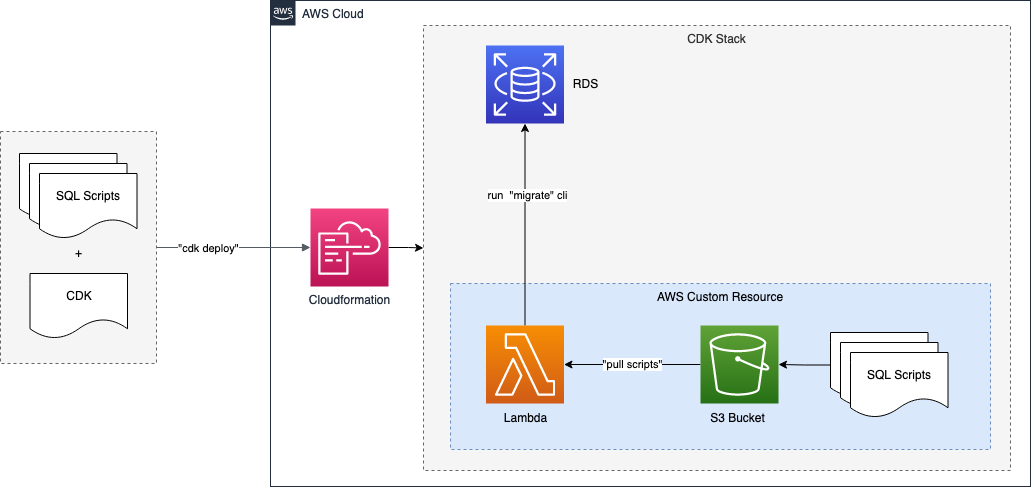db-migrate-cdk v0.0.8
DB Migrate CDK
Apply schema evolutions/database migrations using the golang migrate cli tool in your CDK stack. The key pattern this enables is the ability to initialise (and update) the schema after the database is provisioned but before your application is deployed and tries to connect.
NOTE: migrate supports a number of database types but currently this construct only supports Amazon RDS Instances (mysql or postgres) and Amazon RDS Aurora Clusters (mysql or postgres).
Construct Design
It copies the sql scripts in your local project to an S3 bucket. It uses an AWS Custom Resource to trigger a Lambda function call that takes the scripts from S3 and runs them against the target database. The lambda function is packaged up as a docker image with the 'migrate' cli bundled in.

Cool things you can do with this construct
As part of the CDK stack that provisions your database:
- Create an initial database schema
- Continually update the database schema on each 'cdk deploy'
- Create new database users, roles and manage permissions
- Populate tables with static/ref data
- Populate tables with test data
- Clean and repopulate table data to a known state on each 'cdk deploy'
- Drop the entire schema and recreate on each 'cdk deploy'
Important Context
To have success with this construct you need to understand how db schema evolution/migration tools like migrate, flyway and liquidbase work. In short they apply an ordered sequence of sql scripts (migrations/evolutions) to a target database. The tool maintains a table in the target database to keep track of what the highest applied script is. Each time it runs it checks to see if there is a 'higher' ordered script it can apply and updates its watermark accordingly.
For more details checkout:
- Flyway - Why database migrations
- migrate - Getting Started
Usage
Step 1
Create your ordered sequence of migration scripts in a folder in your project - see migrations guide. eg in \<project_base>/migrations' you might create the file '1_initialize_schema.up.sql' that contains:
CREATE TABLE CUSTOMERS(
ID INT NOT NULL,
NAME VARCHAR (20) NOT NULL,
AGE INT NOT NULL,
ADDRESS CHAR (25) ,
PRIMARY KEY (ID)
);Step 2
In your CDK Stack you create a 'DBMigrate' construct that looks to run the migration scripts created in step 1 against an RDS/Aurora database that has been provisioned earlier in the CDK Stack.
// Run our 'migrate' based schema setup on our mysql instance
const mysqlRdsMigration = new DbMigrate(this, 'MysqlRdsMigrateTask', {
vpc,
targetDatabaseInstance: mysqlRdsInstance,
targetDatabaseName: dbName,
migrationsFolder: './migrations',
})import {
Stack,
StackProps,
CfnOutput,
Token,
aws_rds as rds,
aws_ec2 as ec2,
} from 'aws-cdk-lib'
import { Construct } from 'constructs'
import { DbMigrate, DbMigrateCommand } from 'db-migrate-cdk'
/**
* Provision a test database and executes some test migrations using
* the DbMigrate construct.
*/
export class DbMigrateTestStack extends Stack {
constructor(scope: Construct, id: string, props: StackProps) {
super(scope, id, props)
const vpc = new ec2.Vpc(this, 'MigrateVPC')
// Initial database to create in our database instance
const dbName = 'init'
// Mysql RDS instance
const mysqlRdsInstance = new rds.DatabaseInstance(this, 'MysqlRdsMigrateInstance', {
vpc,
allocatedStorage: 20,
engine: rds.DatabaseInstanceEngine.mysql({
version: rds.MysqlEngineVersion.VER_8_0,
}),
databaseName: dbName,
instanceType: ec2.InstanceType.of(ec2.InstanceClass.T4G, ec2.InstanceSize.MEDIUM),
})
// Run our 'migrate' based schema setup on our mysql instance
const mysqlRdsMigration = new DbMigrate(this, 'MysqlRdsMigrateTask', {
vpc,
targetDatabaseInstance: mysqlRdsInstance,
targetDatabaseName: dbName,
migrationsFolder: `./migrations/${dbName}`,
migrateCommand: DbMigrateCommand.UP,
})
new CfnOutput(this, 'MysqlRdsMigrateTaskResponse', {
value: Token.asString(mysqlRdsMigration.response),
})
}
}Limitations / Other Options
This construct is running 'migrate' via an AWS Lambda function as part of an AWS Custom Resource in AWS Cloudformation. Specifically the lambda function is packaged up as a Docker container that has the 'migrate' cli bundled into the image. This means that your specified migrate command needs to run within the constraits of the Lambda runtime. In particular (as of 11/2022) the command needs to complete within the 15 min runtime limit of AWS Lambda and operate within the compute/memory cap of the lambda runtime.
These constraints should be fine for a large number of usecases. However if not then you might want to consider:
- Running 'migrate' as a stage in a ci/cd pipeline on a container/vm backed build agent
- Running 'migrate' as part of the boot sequence in your application on the compute that drives your application
- Running 'migrate' manually against the target database to do exceptional case scenarios (i.e complex DML changes on large volumes of data that might take over 15 mins to run)
- Some hybrid model of the options above
Credits
The following blog posts were helpful in pulling this construct together:
License
This project is licensed under the Apache-2.0 License.

